View in other NatureServe Network Field Guides
NatureServe
Montana
Utah
Wyoming
Idaho
Wisconsin
British Columbia
South Carolina
Yukon
California
New York
Tiny Swamp Saxifrage - Micranthes apetala
Other Names:
Saxifraga integrifolia Hook. var. apetala, Saxifraga apetala
State Rank Reason (see State Rank above)
Known from two occurrences, one in the East Pioneers and one in the Absaroka-Beartooth Wilderness. Both occurrences are known from single specimen collections. Though little data are available for the species in Montana, the alpine habitat in which it grows is not generally subject to negative impacts from human disturbance.
General Description
Tiny Swamp Saxifrage is a short-lived perennial herb with erect, leafless stems that are 5-10 cm high and arising from a short, often bulblet-bearing rhizome. Rosette leaves are 13-35 mm long and are egg-shaped with a short, broad petiole. The leaves have scattered, long, white or brown hairs, while the stem is densely covered with white, gland-tipped hairs. 5-15 short-stalked flowers are borne in a congested, terminal, egg-shaped cluster. Each saucer-shaped flower has 5 separate, ascending, green sepals that are 1-3 mm long and 10 white stamens attached to the middle of the ovary. The top half of the ovary forms a lobed disk with usually 2 short styles.
Phenology
Flowering in mid-June-July.
Diagnostic Characteristics
Saxifraga has many similar-appearing species; a technical key and hand lens are necessary for identification. Saxifraga oregana var. subapetala also lacks petals, but the stamens are purple. Saxifraga integrifolia is also very similar, but it has petals and the inflorescence is less congested. Saxifraga rhomboidea is the most common high-elevation species, but it also has petals.
Species Range
Montana Range
Range Descriptions
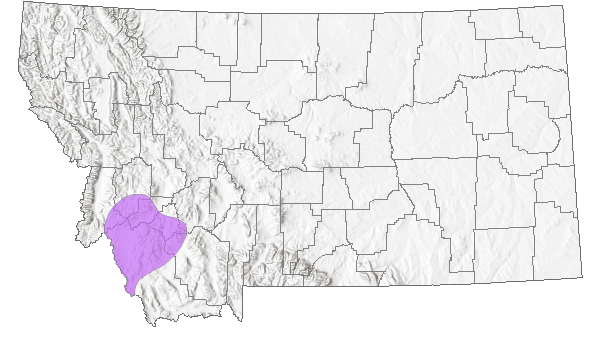
 Native
Native
Range Comments
Range about 10,000+ sq. mi. Occurs along the eastern slope of Washington Cascades (Okanogan to Yakima Counties) and disjunct in Montana.
Observations in Montana Natural Heritage Program Database
Number of Observations: 25
(Click on the following maps and charts to see full sized version)
Map Help and Descriptions
Relative Density
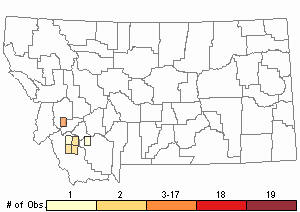
Recency

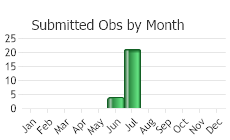
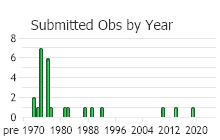
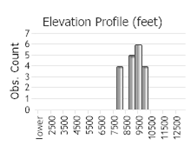 (Observations spanning multiple months or years are excluded from time charts)
(Observations spanning multiple months or years are excluded from time charts)
Habitat
Moist, open, often gravelly soil in meadows and on rock ledges in the montane to alpine zones.
National Vegetation Classification System Groups Associated with this Species
Alpine
Alpine - Sparse and Barren
Alpine - Vegetated
Grassland
Montane - Subalpine Grassland
Wetland and Riparian
Alpine Riparian and Wetland
Stewardship Responsibility
Threats or Limiting Factors
STATE THREAT SCORE REASON
Threat impact not assigned because threats are not known (MTNHP Threat Assessment 2021).
References
- Literature Cited AboveLegend:
 View Online Publication
View Online Publication MTNHP Threat Assessment. 2021. State Threat Score Assignment and Assessment of Reported Threats from 2006 to 2021 for State-listed Vascular Plants. Botany Program, Montana Natural Heritage Program, Helena, Montana.
MTNHP Threat Assessment. 2021. State Threat Score Assignment and Assessment of Reported Threats from 2006 to 2021 for State-listed Vascular Plants. Botany Program, Montana Natural Heritage Program, Helena, Montana.
- Additional ReferencesLegend:
 View Online Publication
View Online Publication
Do you know of a citation we're missing? Elvander, P.E. 1984. The taxonomy of Saxifraga (Saxifragaceae) section boraphila subsection integrifoliae in western North America. Systematic Botany Monographs 3:1-44.
Elvander, P.E. 1984. The taxonomy of Saxifraga (Saxifragaceae) section boraphila subsection integrifoliae in western North America. Systematic Botany Monographs 3:1-44. Johnson, T. W. 1982. An analysis of pack and saddle stock grazing areas in the Bob Marshall Wilderness. M.Sc.Thesis. Bozeman, MT: Montana State University. 105 p.
Johnson, T. W. 1982. An analysis of pack and saddle stock grazing areas in the Bob Marshall Wilderness. M.Sc.Thesis. Bozeman, MT: Montana State University. 105 p. Lesica, P., M.T. Lavin, and P.F. Stickney. 2012. Manual of Montana Vascular Plants. Fort Worth, TX: BRIT Press. viii + 771 p.
Lesica, P., M.T. Lavin, and P.F. Stickney. 2012. Manual of Montana Vascular Plants. Fort Worth, TX: BRIT Press. viii + 771 p. Lesica, P., M.T. Lavin, and P.F. Stickney. 2022. Manual of Montana Vascular Plants, Second Edition. Fort Worth, TX: BRIT Press. viii + 779 p.
Lesica, P., M.T. Lavin, and P.F. Stickney. 2022. Manual of Montana Vascular Plants, Second Edition. Fort Worth, TX: BRIT Press. viii + 779 p.
- Web Search Engines for Articles on "Tiny Swamp Saxifrage"





